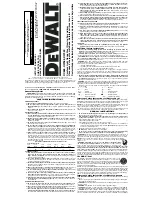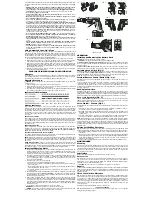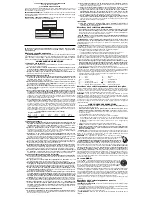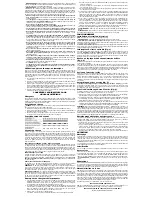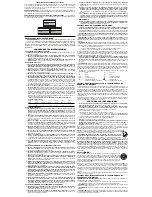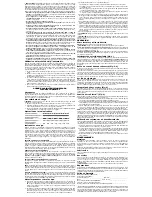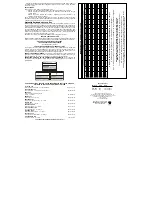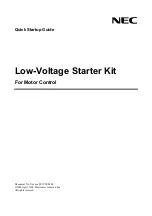
of metallic particles should be kept away from charger cavities. Always unplug the charger from
the power supply when there is no battery pack in the cavity. Unplug charger before attempting
to clean.
•
DO NOT attempt to charge the battery pack with any chargers other than the ones in
this manual.
The charger and battery pack are specifically designed to work together.
•
These chargers are not intended for any uses other than charging D
E
WALT recharge-
able batteries.
Any other uses may result in risk of fire, electric shock or electrocution.
•
Do not expose charger to rain or snow.
•
Pull by plug rather than cord when disconnecting charger.
This will reduce risk of
damage to electric plug and cord.
•
Make sure that cord is located so that it will not be stepped on, tripped over, or other-
wise subjected to damage or stress.
•
Do not use an extension cord unless it is absolutely necessary.
Use of improper
extension cord could result in risk of fire, electric shock, or electrocution.
•
An extension cord must have adequate wire size (AWG or American Wire Gauge) for
safety.
The smaller the gauge number of the wire, the greater the capacity of the cable, that
is 16 gauge has more capacity than 18 gauge. When using more than one extension to make
up the total length, be sure each individual extension contains at least the minimum wire size.
•
Do not place any object on top of charger or place the charger on a soft surface that
might block the ventilation slots and result in excessive internal heat.
Place the
charger in a position away from any heat source. The charger is ventilated through slots in
the top and the bottom of the housing.
•
Do not operate charger with damaged cord or plug
— have them replaced immediately.
•
Do not operate charger if it has received a sharp blow, been dropped, or otherwise
damaged in any way.
Take it to an authorized service center.
•
Do not disassemble charger; take it to an authorized service center when service or
repair is required.
Incorrect reassembly may result in a risk of electric shock, electrocution
or fire.
•
Disconnect the charger from the outlet before attempting any cleaning. This will
reduce the risk of electric shock.
Removing the battery pack will not reduce this risk.
•
NEVER
attempt to connect 2 chargers together.
•
The charger is designed to operate on standard household electrical power (120
Volts). Do not attempt to use it on any other voltage.
This does not apply to the
vehicular charger.
Using Automatic Tune-Up™ Mode
The automatic Tune-Up™ Mode equalizes or balances the individual cells in the battery pack
allowing it to function at peak capacity. Battery packs should be tuned up weekly or after 10
charge/discharge cycles or whenever the pack no longer delivers the same amount of work. To
use the automatic Tune-Up™, place the battery pack in the charger and leave it for at least 8
hours. The charger will cycle through the following modes.
1. The red light will blink continuously indicating that the 1-hour charge cycle has started.
2. When the 1-hour charge cycle is complete, the light will stay on continuously and will no
longer blink. This indicates that the pack is fully charged and can be used at this time.
3. If the pack is left in the charger after the initial 1-hour charge, the charger will begin the
Automatic Tune-Up mode. This mode continues up to 8 hours or until the individual cells in
the battery pack are equalized. The battery pack is ready for use and can be removed at any
time during the Tune-Up mode.
4. Once the Automatic Tune Up mode is complete, the charger will begin a maintenance
charge; the red indicator will remain lit.
SAVE THESE INSTRUCTIONS FOR FUTURE USE
Chargers
Your battery can be charged in D
E
WALT 1 Hour Chargers, 15 Minute Chargers or Vehicular
12 Volt Charger. Be sure to read all safety instructions before using your charger. Consult the
chart at the end of this manual for compatibility of chargers and battery packs.
Charging Procedure
DANGER:
Electrocution hazard. 120 volts are present at charging terminals. Do not probe with
conductive objects.
1. Plug the charger into an appropriate outlet as shown in Figure 1.
2. Insert the battery pack into the charger. The red (charging) light will blink continuously
indicating that the charging process has started.
3. The completion of charge will be indicated by the red light remaining ON continuously. The
pack is fully charged and may be used at this time or left in the charger.
Indicator Light Operation
Charge Indicators
Some chargers are designed to detect certain problems that can arise with battery packs.
Problems are indicated by the red light flashing at a fast rate. If this occurs, re-insert battery
pack into the charger. If the problem persists, try a different battery pack to determine if the
charger is OK. If the new pack charges correctly, then the original pack is defective and should
be returned to a service center or other collection site for recycling. If the new battery pack
elicits the same trouble indication as the original, have the charger tested at an authorized ser-
vice center.
HOT/COLD PACK DELAY
Some chargers have a Hot/Cold Pack Delay feature: when the charger detects a battery that is
hot, it automatically starts a Hot Pack Delay, suspending charging until the battery has cooled.
After the battery has cooled, the charger automatically switches to the Pack Charging mode.
This feature ensures maximum battery life. The red light flashes long, then short while in the Hot
Pack Delay mode.
PROBLEM POWER LINE
Some chargers have a Problem Power Line indicator. When the charger is used with some
portable power sources such as generators or sources that convert DC to AC, the charger may
temporarily suspend operation,
flashing the red light with two fast blinks followed by a
pause
. This indicates the power source is out of limits.
LEAVING THE BATTERY PACK IN THE CHARGER
The charger and battery pack can be left connected with the red light glowing indefinitely. The
charger will keep the battery pack fresh and fully charged.
NOTE:
A battery pack will slowly lose its charge when kept out of the charger. If the battery pack
has not been kept on maintenance charge, it may need to be recharged before use. A battery
pack may also slowly lose its charge if left in a charger that is not plugged into an appropriate
AC source.
WEAK BATTERY PACKS:
Chargers can also detect a weak battery. Such batteries are still
usable but should not be expected to perform as much work. In such cases, about 10 seconds
after battery insertion, the charger will beep rapidly 8 times to indicate a weak battery condition.
The charger will then go on to charge the battery to the highest capacity possible.
Important Charging Notes
1. Longest life and best performance can be obtained if the battery pack is charged when the
air temperature is between 65°F and 75°F (18°- 24°C). DO NOT charge the battery pack in
an air temperature below +40°F (+4.5°C), or above +105°F (+40.5°C). This is important and
will prevent serious damage to the battery pack.
2. The charger and battery pack may become warm to touch while charging. This is a normal
condition, and does not indicate a problem. To facilitate the cooling of the battery pack after
use, avoid placing the charger or battery pack in a warm environment such as in a metal
shed, or an uninsulated trailer.
3. If the battery pack does not charge properly:
a. Check current at receptacle by plugging in a lamp or other appliance
b. Check to see if receptacle is connected to a light switch which turns power off when you
turn out the lights.
c. Move charger and battery pack to a location where the surrounding air temperature is
approximately 65°F - 75°F (18°- 24°C).
d. If charging problems persist, take the tool, battery pack and charger to your local
service center.
4. The battery pack should be recharged when it fails to produce sufficient power on jobs which
were easily done previously. DO NOT CONTINUE to use under these conditions. Follow the
charging procedure. You may also charge a partially used pack whenever you desire with no
adverse affect on the battery pack.
5. Under certain conditions, with the charger plugged into the power supply, the exposed
charging contacts inside the charger can be shorted by foreign material. Foreign materials
of a conductive nature such as, but not limited to, steel wool, aluminum foil, or any buildup
of metallic particles should be kept away from charger cavities. Always unplug the charger
from the power supply when there is no battery pack in the cavity. Unplug charger before
attempting to clean.
6. Do not freeze or immerse charger in water or any other liquid.
WARNING:
Shock hazard. Do not allow any liquid to get inside charger.
CAUTION:
Never attempt to open the battery pack for any reason. If the plastic housing of the
battery pack breaks or cracks, return to a service center for recycling.
A
B
FIG. 2
FIG. 4
FIG. 5
FIG. 3
C
VERSA-CLUTCH™
OPERATION
Installing and Removing the Battery Pack
NOTE:
Make sure your battery pack is fully charged.
CAUTION:
Lock trigger switch before removing or installing battery.
To install the battery pack into the tool handle
, align the base of the tool with the notch inside
the tool’s handle and slide the battery pack firmly into the handle until you hear the lock snap
into place (Fig. 2).
To remove the battery pack from the tool
, press the release buttons and firmly pull the
battery pack out of the tool handle. Insert it into the charger as described in the charger manual.
Variable Speed Switch (Fig. 3)
To turn the tool ON, squeeze the trigger switch (A). To turn the tool OFF release the trigger. Your
tool is equipped with a
variable speed switch
which enables you to select the best speed for
a particular application. The farther you squeeze the trigger, the faster the tool will operate. For
maximum tool life, use variable speed only for starting fasteners.
Forward/Reverse Control Button (Fig. 3, 4)
A forward/reverse control button (B) determines the direction of the tool and also serves as a
lock-off button.
To select forward rotation, release the trigger switch (A) and depress the forward/reverse
control button (B) on the right side of the tool. To select reverse, depress the forward/reverse
control button on the left side of the tool. The center position of the control button locks the tool
in the OFF position. When changing the position of the forward/reverse control button, be sure
the trigger is released.
Dead Spindle Action
All D
E
WALT light gauge screwdrivers provide a
dead front spindle to permit fasteners to be
located in the driving accessory. Clutches are held apart by light spring pressure, permitting the
drilling clutch to rotate without turning the driven clutch and accessory. When sufficient forward
pressure is applied to the unit, the clutches engage and rotate the spindle and accessories.
Accessory Assembly (Fig. 5)
The 1/4”
hex drive ball lock chuck
is a quick-release system. To install a bit, pull out on the
spindle collar (C), insert the bit of choice and release. The tool is locked in place. To remove the
bit, pull out the spindle collar and take out the bit.
Versa Clutch™ Feature (Fig. 5)
External adjustment of all Versa Clutch™ units for a wide range of fastener sizes is fast and easy
as follows:
1. Pull forward, then rotate collar in increase direction (stamped on adjustment collar) to
increase the amount of clutch engagement and torque output.
2. Maximum rotation of the collar in the increase direction results in full clutch engagement and
maximum torque output and fastener capacity. Collar and adjustable stop will not screw off
clutch housing.
3. Test drive a fastener into a scrap piece to check proper fastener seating. It is normal after a
period of use to require a slightly different collar setting due to wear on the clutch faces.
NOTE:
With Versa Clutch™, the operator has the ability to “override” clutch ratchet if a fastener
hits a wood knot, variable hardness in steel work pieces or incorrect pilot holes. Increased operator
pressure will usually cause the clutches to pick-up and continue to seat the fastener. Further, a
quick twist of the collar will change the clutch setting to overcome most driving difficulties and will
provide for immediate change in torque output giving the operator the option to drive a wide range
of fastener sizes.
Driving Self-Drilling Fasteners
D
E
WALT screwdrivers are designed to safely deliver self-drilling screws into light gauge metal
including drywall studs, heat ducting and sheet metal assembly without pre-drilling a pilot hole.
1. Select proper length self drilling screw to ensure complete fastening into the metal stud or
sheet metal.
2. More pressure can be applied to the bit if the screwdriver is gripped by sliding the thumb and
index finger along the side of the tool near the top. Actuate the trigger with middle and/or
fourth finger. D
E
WALT has designed recesses along the top sides of your screwdriver to
allow for a comfortable grip.
3. Avoid driving self-drilling fasteners into very heavy gauge steel without a drilled pilot hole.
MAINTENANCE
Cleaning
With the motor running, blow dirt and dust out of all air vents with dry air at least once a week.
Wear safety glasses when performing this. Exterior plastic parts may be cleaned with a damp
cloth and mild detergent. Although these parts are highly solvent resistant, NEVER use solvents.
Depth locator and adjustment collar should be removed and dust blown out of clutch area
housing at least once a week.
Lubrication
All ball and needle bearings are factory lubricated for the life of the tool.
Accessories
Recommended accessories for use with your tool are available at extra cost from your local ser-
vice center. If you need any assistance in locating any accessory, please contact D
E
WALT
Industrial Tool Co., 701 East Joppa Road, Baltimore, MD 21286, call 1-800-4-D
E
WALT (1-800-
433-9258) or visit our website www.dewalt.com.
CAUTION:
The use of any non-recommended accessory may be hazardous.
Repairs
To assure product SAFETY and RELIABILITY, repairs, maintenance and adjustment (including
brush inspection and replacement) should be performed by a D
E
WALT factory service center, a
D
E
WALT authorized service center or other qualified service personnel. Always use identical
replacement parts.
Three Year Limited Warranty
D
E
WALT will repair, without charge, any defects due to faulty materials or workmanship for three
years from the date of purchase. This warranty does not cover part failure due to normal wear
or tool abuse. For further detail of warranty coverage and warranty repair information, visit
www.dewalt.com or call 1-800-4-D
E
WALT (1-800-433-9258). This warranty does not apply to
accessories or damage caused where repairs have been made or attempted by others. This
warranty gives you specific legal rights and you may have other rights which vary in certain
states or provinces.
In addition to the warranty, D
E
WALT tools are covered by our:
1 YEAR FREE SERVICE
D
E
WALT will maintain the tool and replace worn parts caused by normal use, for free, any time
during the first year after purchase.
FIG. 1

